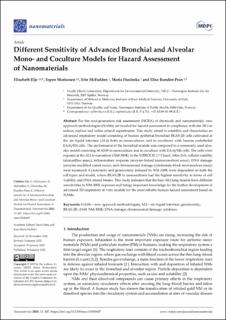Different Sensitivity of Advanced Bronchial and Alveolar Mono- and Coculture Models for Hazard Assessment of Nanomaterials
Peer reviewed, Journal article
Published version
Permanent lenke
https://hdl.handle.net/11250/3044869Utgivelsesdato
2023Metadata
Vis full innførselSamlinger
- Publikasjoner fra Cristin - NILU [1360]
- Vitenskapelige publikasjoner [1096]
Sammendrag
For the next-generation risk assessment (NGRA) of chemicals and nanomaterials, new approach methodologies (NAMs) are needed for hazard assessment in compliance with the 3R’s to reduce, replace and refine animal experiments. This study aimed to establish and characterize an advanced respiratory model consisting of human epithelial bronchial BEAS-2B cells cultivated at the air–liquid interface (ALI), both as monocultures and in cocultures with human endothelial EA.hy926 cells. The performance of the bronchial models was compared to a commonly used alveolar model consisting of A549 in monoculture and in coculture with EA.hy926 cells. The cells were exposed at the ALI to nanosilver (NM-300K) in the VITROCELL® Cloud. After 24 h, cellular viability (alamarBlue assay), inflammatory response (enzyme-linked immunosorbent assay), DNA damage (enzyme-modified comet assay), and chromosomal damage (cytokinesis-block micronucleus assay) were measured. Cytotoxicity and genotoxicity induced by NM-300K were dependent on both the cell types and model, where BEAS-2B in monocultures had the highest sensitivity in terms of cell viability and DNA strand breaks. This study indicates that the four ALI lung models have different sensitivities to NM-300K exposure and brings important knowledge for the further development of advanced 3D respiratory in vitro models for the most reliable human hazard assessment based on NAMs.

